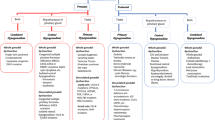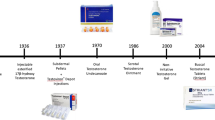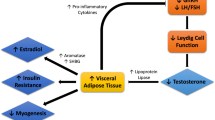Abstract
A progressive decrease in androgen production is common in aging men. The physiological causes for this phenomenon seem to be multifactorial. The magnitude of the decline in testosterone with age and the prevalence of older men with low testosterone levels have not been well established. The extent to which an age-dependent decline in androgen levels leads to health problems that might affect or alter the quality of life remains under debate. In men older than middle age, total testosterone levels may be misleading because of an increase in sex hormone-binding globulin levels. The mechanism of the age-associated decrease of the endocrine testicular function is also essentially due to primary testicular failure, but important changes occur at the hypothalamopituitary level. The most prominent endocrinological alterations with aging are related to the sex steroids, but others, such as growth hormone, melatonin cortisol, and thyroxine, are also affected. The clinical picture of andropause syndrome is characterized by diminished sexual desire and erectile capacity, decrease in intellectual activity, fatigue, depression, decrease in lean body mass, skin alterations, decrease in body hair, decrease in bone mineral density that results in osteoporosis, and increase in visceral fat and obesity. Current medical treatments for androgen supplementation include oral tablets, intramuscular injections, and scrotal and nonscrotal patches. Unfortunately, none of these preparations mimic the circadian rhythm, even if some of them may approximate the circadian rhythm by dose adjustments. Moreover, the androgen supplementation could have adverse effects on different organs, namely, the liver, lipid profile, cardiovascular disease, prostate, sleep disorders, and emotional behavior. Clinical response is a better guide to dose requirements, regardless of serum testosterone levels. This important field must be actively investigated by the medical, behavioral, and social sciences.
This is a preview of subscription content, access via your institution
Access options
Subscribe to this journal
Receive 8 print issues and online access
$259.00 per year
only $32.38 per issue
Buy this article
- Purchase on Springer Link
- Instant access to full article PDF
Prices may be subject to local taxes which are calculated during checkout
Similar content being viewed by others
Author information
Authors and Affiliations
Corresponding author
Rights and permissions
About this article
Cite this article
Wespes, E., Schulman, C. Male andropause: myth, reality, and treatment. Int J Impot Res 14 (Suppl 1), S93–S98 (2002). https://doi.org/10.1038/sj.ijir.3900798
Published:
Issue Date:
DOI: https://doi.org/10.1038/sj.ijir.3900798
Keywords
This article is cited by
-
“Leaving no one behind” also includes taking the elderly along concerning their sexual and reproductive health and rights: a new focus for Reproductive Health
Reproductive Health (2020)
-
Hypogonadism in men with erectile dysfunction may be related to a host of chronic illnesses
International Journal of Impotence Research (2010)
-
Psychometric evaluation of the WHOQOL-BREF in community-dwelling older people in Taiwan using Rasch analysis
Quality of Life Research (2009)
-
Predicting hypogonadism in men based upon age, presence of erectile dysfunction, and depression
International Journal of Impotence Research (2006)
-
Phytoadaptogen correction of clinical and immunobiological parameters in patients with benign prostatic hyperplasia
Bulletin of Experimental Biology and Medicine (2006)



